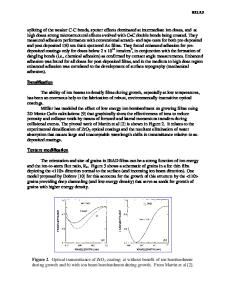Ion beam characterization and treatment
- PDF / 1,873,224 Bytes
- 10 Pages / 613 x 789 pts Page_size
- 32 Downloads / 313 Views
I.
INTRODUCTION
THE development
of ion beam techniques in materials science can be illustrated by the history of ion-induced nuclear reactions between accelerated ions and lithium atoms. When Cockroft and Walton m "split the atom" in 1932, they used the first ion accelerator to bombard lithium with protons and discovered the reaction 7Li + p ~ 4He + 4He This is an example of a large class of ion-induced nuclear reactions in which energetic particles are emitted. Nuclear physicists studied these reactions for many years. Much later, as their field moved on to heavy ion reactions and to ever-higher energies, work on such lowenergy reactions languished. But these reactions can also be used for materials analysis; for example, in 1986, a similar reaction was being used by Schulte et al. at the Grumman Corporate Research Center for measurement of lithium profiles in AI-Li alloys, t2~ In fact, as each new facet of ion interaction with solids has been discovered, it has been studied for a while for its own sake, then typically allowed to sink into obscurity, later to be mined from the literature and pressed into service by materials scientists for use as a tool. At the same time, "the target" becomes "the sample." Another excellent example of this process is the discovery by Geiger and Marsden of alpha particle backscattering from a thin target. "As incredible," Rutherford said, "as if you fired fifteen-inch shell at a sheet of tissue paper and it came back and hit you." At the time, this fundamental discovery was at the frontier of physics. Today, Rutherford backscattering is a routine technique in materials analysis, as I will show. The theme of this paper will be that the study of ionA.D. M A R W I C K , Research Staff Member, is with the IBM T.J. Watson Research Laboratory, IBM Research Division, P.O. Box 218, Yorktown Heights, NY 10598. This paper is based on a presentation made in the s y m p o s i u m "Irradiation-Enhanced Materials Science and Engineering" presented as part of the ASM I N T E R N A T I O N A L 75th Anniversary celebration at the 1988 World Materials Congress in Chicago, IL, September 2 5 - 2 9 , 1988, under the auspices of the Nuclear Materials Committee of T M S - A I M E and ASM-MSD. METALLURGICAL TRANSACTIONS A
solid collision physics has given materials scientists a rich variety of useful tools. My aim is to give a brief introduction to these tools and to give examples of their use for analysis, characterization, and materials modification. My hope is that this article will be useful to people outside the field as an overview and a pointer to more detailed information, as well as an introduction to some advanced research. In a short paper, it is impossible to be exhaustive or even complete. Where possible, I have referred to reviews of each subtopic so that it can be explored in more detail, I have also tried to emphasize the most m o d e m computer codes and other standard sources of information which so greatly facilitate the application of ion-solid collision physics in materials scienc
Data Loading...











